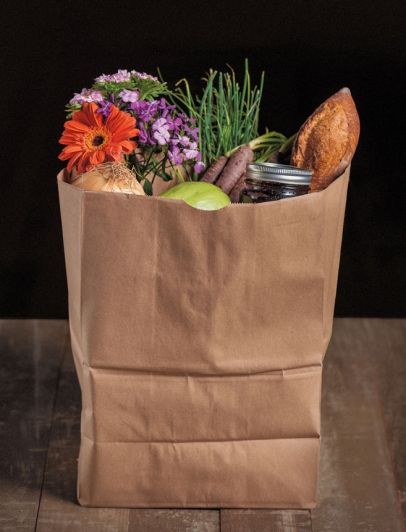Op-Edible
Save a Tree: Use a Paper Bag
‘Paper or plastic?’ is no contest in this farmer’s view
We’re all familiar with the idea that to save a tree, we should reduce our paper usage. “Think before you print” anchors the end of emails. Grocery stores encourage you to bring your own bags or buy their reusable bags—anything to reduce your use of the brown paper bag. The “brown bag” lunch has gone the way of peanut butter in schools.
The argument used to be paper versus plastic. Advocates of both sides of the issue have written reams of arguments (pun intended) claiming science supports their views. For anyone who has seriously considered the issue, paper is carrying the day. Recently, San Francisco banned plastic bags at groceries and pharmacies. China banned plastic bags in June. Whole Foods doesn’t have plastic bags at checkout. Apple, in conjunction with The Conservation Fund, recently began buying its own timber forests to sustainably source trees for paper packaging. Of course, single-use plastic bags are a dubious use for precious petroleum. A plastic bag that winds up in a stream or bayou is a long-term problem while a paper bag that does the same is long-term fertilizer.
We have been taught that plastic is bad and paper is, simply, less bad. Superficially, there is certainly logic behind the argument against paper. Paper bags are made from trees, so it seems to make sense that eliminating paper bags would save the trees. Besides that, we all have an emotional attachment to trees. We climb them when we are young and build little houses in them when we can. The copy editor for this publication does much of his editing from a tree house, in fact. Live oaks thrive on our most storied streets, Saint Charles and Esplanade, as well as in our parks. One of the great losses of Katrina was the trees. And we place high esthetic values on the large cypress trees in nearby swamps. These are trees worth saving. But they are not the types of trees that go into paper bag making.
My family has been farming for many generations. My grandfather practiced sustainable forestry when he planted loblolly pines early in the 20th century to replace trees used to rebuild his family’s home, which had burned. As a preschooler I played under the trees he planted. When I was around 10 I helped my father and brother plant improved loblollies. My father pointed to pine trees on his farm when I was in high school, saying, “Those will pay for your college education.” And they did.
I purchased my first farm about 35 years ago. It had been mostly used for grazing cattle, planted in fescue. Fescue doesn’t do much for wildlife, but it is good for soil retention. I planted the entire farm in pines. Now wildlife abounds, especially deer and turkeys. We have thinned the trees to keep them healthy, and the forest is a now mature, saw-timber-sized trees.
When a farmer thins the trees, he or she is removing the pulpwood. As a tree farmer I can tell you that sustainably grown timber, especially the pulpwood from which paper is made, actually results in more trees, not fewer.
Typically it takes pine timber something like 30 years to reach the mature stage. So, we get one or two harvest rotations during an adult lifetime. And make no mistake: It is saw timber that we primarily are growing. Saw timber is used for lumber that goes into residential home building. Some goes for poles. These are the highest and best uses of pine timber, and these uses command a premium in the marketplace. Pulpwood timber, from which paper is made, and some other lower-value timber products result from the process of growing saw timber.
The seedlings are planted relatively close together. As they mature they begin to crowd each other, competing for sunlight, water and nutrients. The trees become weaker. The weakened trees invite insects and disease to attack. The southern pine bark beetle is a prime example. An infestation begins with a colony attacking a weak tree. The offspring of these beetles spread to nearby healthier trees. If left unchecked, the beetles can destroy large acreages in a short time. The best way to combat these beetles is to maintain a healthy forest through thinning operations. Moreover, thinning reduces the hazard of forest fires.
So, we thin the forests that we grow. Between planting and final saw timber harvest, a pine forest must be thinned several times to remain healthy. The young trees least likely to produce quality saw timber are removed. The trees that are removed during the first thinning are typically sold for pulpwood. As the trees become larger some of the trees from successive thinning may be small saw timber sized or may be used for oriented strand boards (OSB), however much of it continues to go to paper mills as pulpwood.
Paper mills and logging provide good jobs here in Louisiana and other Southeastern states. The first paper mill built in the rural community where I grew up provided the best hourly wage jobs anywhere around. Those were plum jobs for many people. During summers while I was in college, I worked for two different paper mills. The one in our community typically hired around 20 college students each summer. These summer jobs were coveted. Over the years that mill helped a good number of students with their educations.
If there were no market for paper, the forest would still need to be thinned. With less demand for pulpwood, perhaps the timber farmer would get less for his pulpwood trees. But he would still cut them during thinning operations for the health of the remaining trees.
I recall a period a few years ago when timber farmers in some areas of the Southeast were actually paying loggers to thin pine forests.
Why is timber farming mostly about producing saw timber? The answer lies in simple economics. According to the Louisiana Department of Agriculture and Forestry, during the fourth quarter of 2014 pine pulpwood stumpage prices were $9.53 per ton and saw timber stumpage prices were $34.12 per ton here in Louisiana. (Stumpage prices are the value the farmer receives for standing timber.) And the uplift for saw timber over pulpwood has historically been greater than that. So it makes economic sense for forest farmers to grow their timber out to full saw timber size before clear cutting and replanting. Importantly, we do not clear cut our timber for pulpwood. That would be economic suicide for us. Pulpwood is mainly a byproduct in the overall timber farming process.
So, given that family timber farming is a for-profit business resulting in pine pulpwood for paper and other uses and more mature trees for building products, are there any benefits from tree farming other than the potential profit to the farmer?
Yes: Our forests sequester carbon, clean and filter water, offer recreational opportunities and provide wildlife habitat.
Of course, timber farming provides major benefits for air quality; trees turn carbon dioxide into oxygen. They sequester the carbon they remove from carbon dioxide for long to indefinite periods of time. One of the most important qualities of paper bags is that they biodegrade, that is, they become nutrient-rich soil. Those who argue against paper bags say that as they biodegrade they release carbon back into the environment. While this is true, it misses the point. Remember the main purpose of timber farming is to produce saw timber, which generally goes into home building. As I am typing this, I’m sitting in a New Orleans home built about 150 years ago. It is almost all original, so the carbon in the trees from which it was constructed was sequestered over the 30 or 40 years before it was built and is still sequestered today. Barring a catastrophe it will remain so for another 150 years.
The pine forest filters and protects water run-off. The ground in a pine forest is largely undisturbed even during a clear cut for saw timber. This helps protect against soil erosion. The American Tree Farm System (ATFS), which certifies our forests, sets standards that encompass Best Management Practices (BMP) to protect air, water, soil and site quality. They set out obligations to protect threatened and endangered species. An example of a BMP is to not clear cut timber from streamside zones, thus providing continuity of timber and ground cover in those areas.
Another tenet of ATFS certification is sustainability. Pines on our farms vary from those most recently planted at 3 years old to some that are over 30 years old. On average our trees are over 20. When we cut trees during final harvest, we replant them to begin the cycle again. So, as long as our forest properties are not converted to another use, our pines will average 15 to 20 years old into perpetuity.
In a state that calls itself the “sportsman’s paradise,” hunting and fishing are very important. Timber farms are often used by hunting clubs for deer, hogs and small upland game. The farms protect our streams, lakes and marshes from silt, thus improving opportunities for fishing and other water activities. There are, also, opportunities for bird watching and hiking.
On my walks in one of our family forests in the last week or so, I saw deer, wild hogs, a bobcat, turtles, crows, hawks, eagles, pileated woodpeckers and a great number of small birds. In the past I have seen coyotes, cougars and various reptiles. For a couple of years I saw a mammal that I did not recognize on one of our Texas farms. It was cat-like with a whimsical face. I did not mention it for a long time; what would people think? After a visitor saw it, I told people about it and called the state wildlife folks. We concluded it was a jaguarondi, a small cat previously unreported north of the Rio Grande Valley. Then a couple of weeks ago I photographed a bird that has yet to be identified by professional ornithologists.
If timber farmers’ lands were not devoted to working forests, they would likely be used for cattle grazing, crops or development, none of which would provide the same level of environmental conservation as tree farming.
So when I have a choice I choose paper bags. As a timber farmer I know I am not helping to destroy any trees if I use a paper bag. I know that using this bag is helping at the margin a tree farmer somewhere sustainable grow trees. I know that I am helping the environment in a number of ways.





